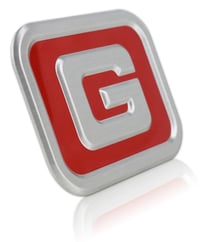Considerations for Exterior Aluminum Badges
Designing an aluminum nameplate or badge for exterior environments means considering the badge during its product housing design. It's more than placing a sticker on the end product or pad printing a logo and calling it good.
Exterior badges for automotive, recreational vehicles, motorcycles and boat trim can be subject to some brutal environments including vibration, upkick of sand or rocks, dents, etc. We can help you understand the limitations and solutions. The three most frequently discussed considerations are:
- Protective topcoats for exterior appliction
- Raw metal edges and exposure to the elements
- Attachment to the product
Exterior Topcoats for Aluminum Badge Protection
Exposure to the elements like sun, snow and dirt can be brutal for the longevity of the look for your aluminum badge. Knowledge of this helps make sure that the correct decorative processes, ink systems and protective top coats are used to make sure that your brand identity stays looking good for years.
 Raw Metal Edges
Raw Metal Edges
When parts are cut out of the sheet of metal, the edges are raw aluminum. These areas do not have the protective top coat. Discussion for the appropriate solution for this may show that this is not an area of concern. It also could involve creating a recess into the housing of the end product or vehicle into which the aluminum badge would be placed. Another option could be to design the aluminum badge with a formed over skirt so that there is a finished edge to the part.
 Attachment to Your Product
Attachment to Your Product
Several options exist to attach an exterior badges to its mating surface. Our engineers can help you understand the benefits and limitations of each. One of the most common solutions for this is to use a pressure sensitive adhesive so that the aluminum badge sticks to the mating surface. Other options can be reviewed to include attachment with rivets or snap in tabs.
Understanding the environment that your product identification will be exposed to helps make sure that proper decorating processes, top coats and adhesives are used. If you are unsure of the specs, discussion can take place so that proper recommendation is made and costs are compiled with accuracy to achieve the best look and quality for your production parts.
Have an exterior application to review? Let's talk!
Subscribe to Nameplate Blog
- 2021 (1)
- 3D (4)
- Adhesives (11)
- Aluminum (129)
- Aluminum In-mold (9)
- Aluminum Trim (41)
- Anodize (4)
- Appliance (12)
- Appliqué (5)
- Archive (35)
- Artwork Submission (4)
- Assembly (6)
- Automotive (35)
- Backlit (5)
- Boats (6)
- Brass (8)
- Brushed Aluminum (19)
- Carbon Fiber (2)
- Classic (1)
- Coined (5)
- Color Development (25)
- Computers (13)
- Cosmetics (24)
- Custom Patterns (11)
- Customization (16)
- Customized Patterns on Aluminum (2)
- Debossing (13)
- Diamond Cut (22)
- Digital Printing (2)
- ebook (4)
- Electronics (23)
- Embossing (53)
- Etched (20)
- Exterior (9)
- FAQ (29)
- Faux Finish (1)
- Faux Finishes (7)
- Favorite Nameplate (20)
- Furniture (9)
- Gauges (5)
- Gloss (4)
- Hang Tag (1)
- IDSA (1)
- In-mold Decoration (5)
- Individual Letters (7)
- Inlay (1)
- Key Fob (1)
- Labels (10)
- Large Vehicle (4)
- Laser Etch (2)
- Lithography (3)
- Match Box Cover (6)
- Materials and Processes (118)
- Mechanical Finishes (51)
- Medical Equipment (10)
- Metallic (8)
- Motorcycle (11)
- Nameplate (175)
- Nameplate Examples (54)
- Nameplate Tools (7)
- Outdoor Equipment (4)
- Overlay (7)
- Packaging (15)
- Patina Finish (3)
- Plastic (1)
- Plastic Trim (3)
- Point of Purchase (8)
- Polycarbonate (10)
- Process Color (16)
- Promotional Products (38)
- Prototypes (2)
- Recreational Vehicles (6)
- Resources (11)
- Safety Labels (2)
- Selective Patterns (10)
- Sill Plate (6)
- Sports Equipment (9)
- Stainless Steel (17)
- stock dies (10)
- Surfaces (4)
- Sustainability (1)
- Technical (1)
- Telecommunications (9)
- Testing (3)
- Texture (15)
- Top 10 (9)
- Woodgrain (2)






